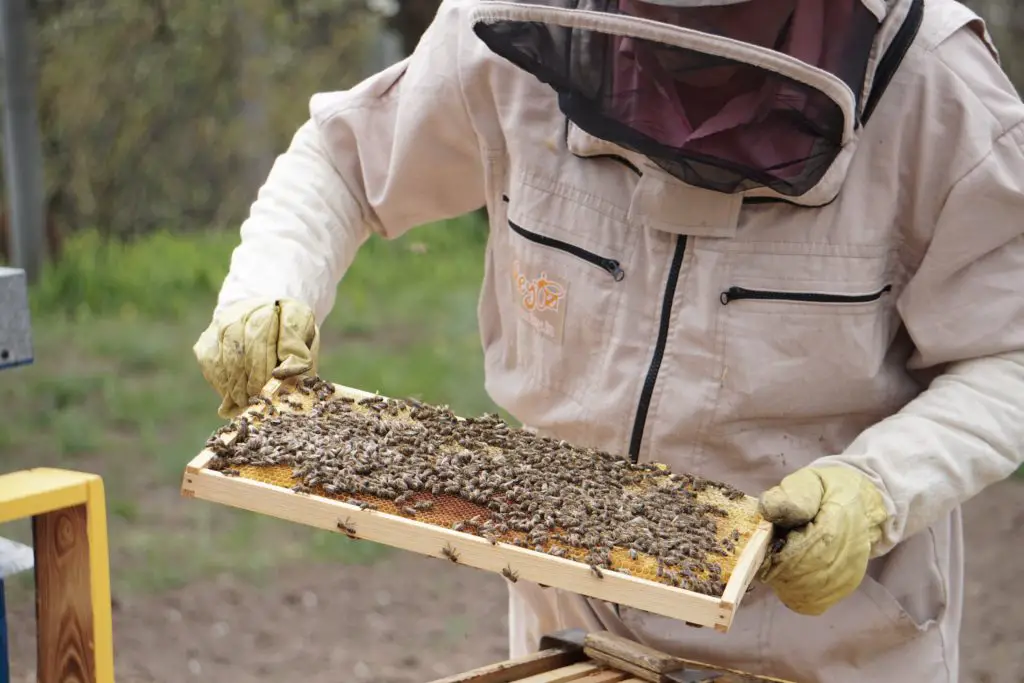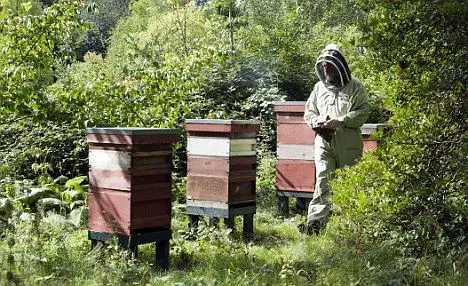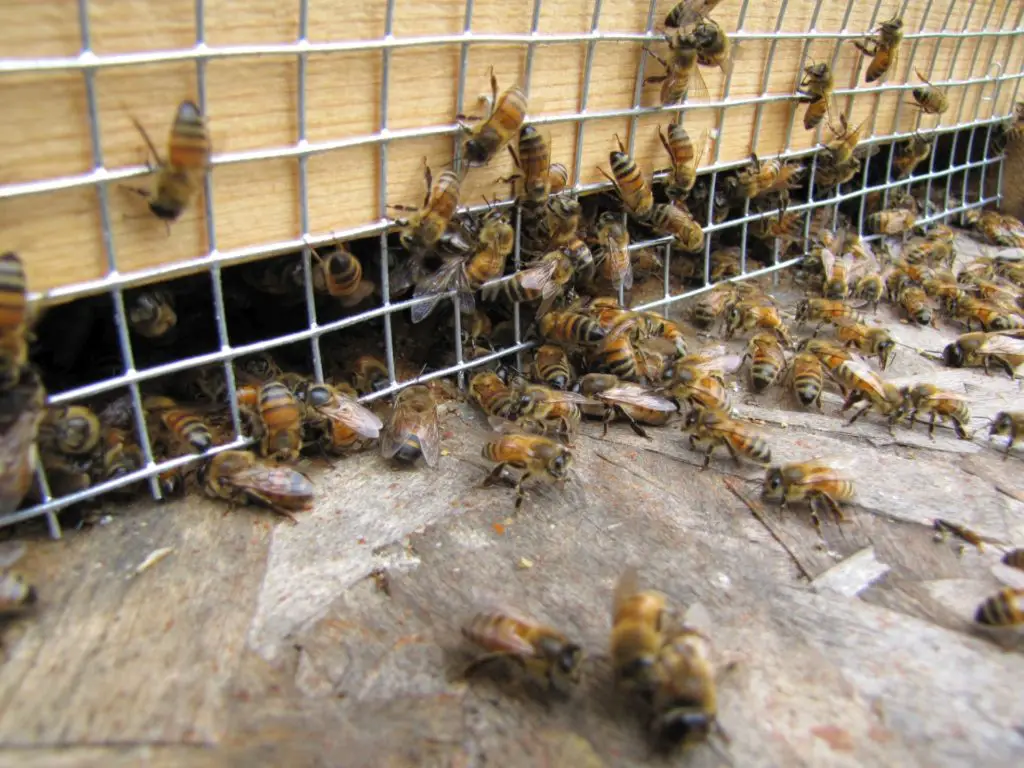Affiliate Disclaimer - As an Amazon Associate I earn from qualifying purchases.
It supports the website. So, Thank you
Bees are important for the environment, but they can also be dangerous. Can you handle bees without a suit?
Bee stings are painful and can be dangerous if you are allergic to them. If you are not allergic, bee stings can still be dangerous if you get too many of them. Bee venom can cause swelling and pain.
If you are going to work with bees, it is important to wear a protective suit. This will protect you from getting stung. It is also important to learn how to handle bees safely. You should never try to pick up a bee or move it around.
Can You Handle Bees Without a Suit?
It is possible to work with bees without a suit, but it’s not recommended. If you’re not experienced with handling bees, it’s best to play it safe and wear a protective suit. Even if you are experienced, there’s always the potential for something to go wrong, so it’s always important to be prepared.
Table of Contents
Can you touch bees with your bare hands?
It is not advisable to handle or touch bees without any gloves or protection for your hands and face as the risk of getting stung is high and bee stings can hurt and potentially kill if you have an adverse allergic reaction.
To reduce the chances of being stung:
- Move slowly and deliberately to reduce your bees’ aggression.
- Avoid wearing perfume, aftershave, or scented lotions when around bees which will attract bees and increase any contact.
- Don’t wear brightly colored clothing or jewelry.
- Try to stay calm and avoid sudden movements if you see a bee nearby.
- Keep your distance from bees by using a long-handled brush or broom rather than reaching into their hives.
- Wear a protective suit, gloves, and face mask if you’re not experienced with handling bees.
- If you are stung, remove the sting as quickly as possible by scraping it off with a fingernail or a credit card. Apply ice to the area to reduce swelling.
- If you have an adverse reaction to the bee’s sting, seek medical attention.
Recommended Beekeeper’s Gloves
I have consistently used these Premium Beekeeping Gloves as, although they may be slightly more expensive than some other brands, I have found that with the soft leather, dexterity is not lost and with the multi-layer mesh, it does well to protect from most bee stings.

What protective gear do beekeepers wear?
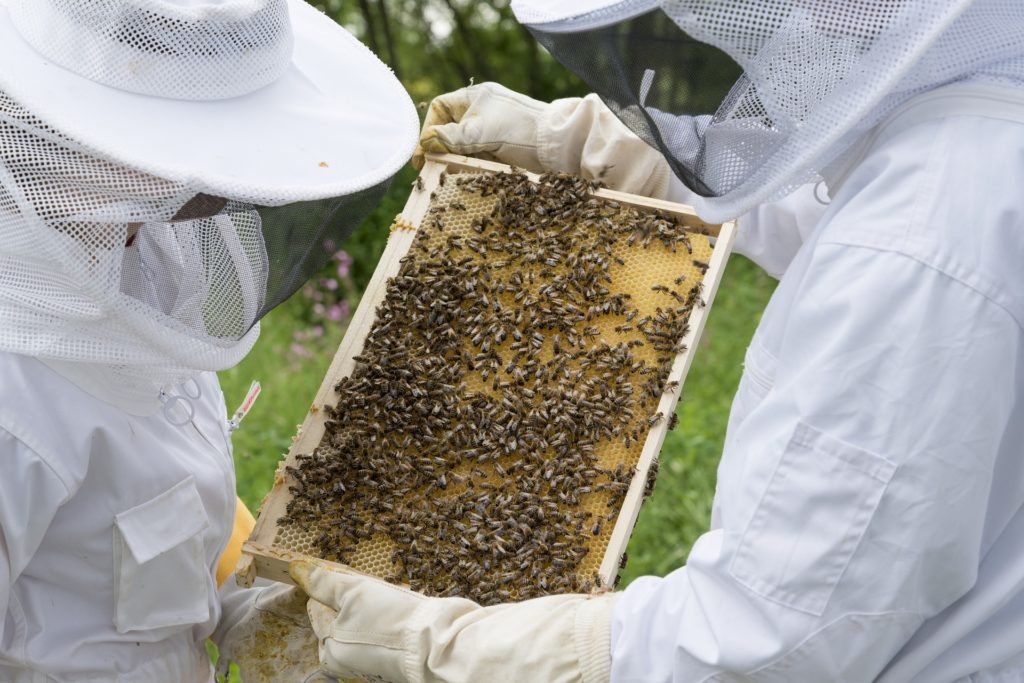
Beekeepers wear protective clothing to avoid getting stung by their bees. The most common pieces of gear worn by beekeepers are a bee suit, veil, and gloves.
Beekeepers wear protective gear to reduce the number of stings they receive, for example, wearing beekeeping gloves is a good way to avoid getting stung on the hands.
Headgear is necessary to protect against bee stings to the head, face, and neck which are very vulnerable areas, especially when opening a hive as the bees are more likely to leave the hive in greater numbers, increasing the risk of being stung.
A bee suit is a full body suit with long sleeves and trousers, often made of cotton or light synthetic fabric, which helps to protect the skin from bee stings.
Veils worn by beekeepers usually have a wire mesh that covers the entire face, except for the eyes, and this protects the face and neck from bee stings.
Most beekeepers also wear Wellington boots to keep their feet protected when working with bees.
Do you need a beekeeper suit?
A beekeeper suit is the most popular type of beekeeping clothing. It is possible to handle bees without a suit, but it’s not recommended. If you’re not experienced in handling bees, it’s best to play it safe and wear a beekeeper suit. Even if you are experienced, there’s always the potential for something to go wrong, so it’s always important to be prepared.
What is a beekeeper suit?
A beekeeper suit will protect your body from bee stings. Protective clothing comes in a wide range of quality and pricing.
It is important to have a well-fitting suit so that the bees cannot get under the suit and sting you. The best suits are made of durable materials and stay comfortable during times spent outdoors with bees.
A beekeeper veil will protect your head, face, and neck from bee stings. A veil is a good idea if you are not wearing a full beekeeping suit.
Beekeeping gloves will protect your hands from bee stings. Gloves should be light-colored so that you can see any stings that may happen.
Boots are also important to wear when working with bees as they will protect your feet from getting stung.
Top 5 Beekeeper Suits
Alternative Bee Protective Clothing Options
There are many other options to consider when shopping for needed beekeeping supplies. A beekeeper suit is the most popular, but it’s not the only option.
The best suits and jackets are thick cotton or a cotton/polyester blend, have ventilated seams, fit snugly with elastic or Velcro closures, and have multiple pockets that seal.
Many people choose to wear a hat and veil instead of a full beekeeping suit. This setup is less expensive and can be just as effective at protecting you from bee stings.
Another option is to wear long pants and a long-sleeved shirt. Many people find this to be enough protection when working with bees.
Whatever you choose, make sure that it fits well and covers all of the areas that are vulnerable to bee stings.
Types of bee protective clothing:
- Beekeeper suit
- Gloves
- Hat and veil
- Wellington boots
- Long pants and shirt
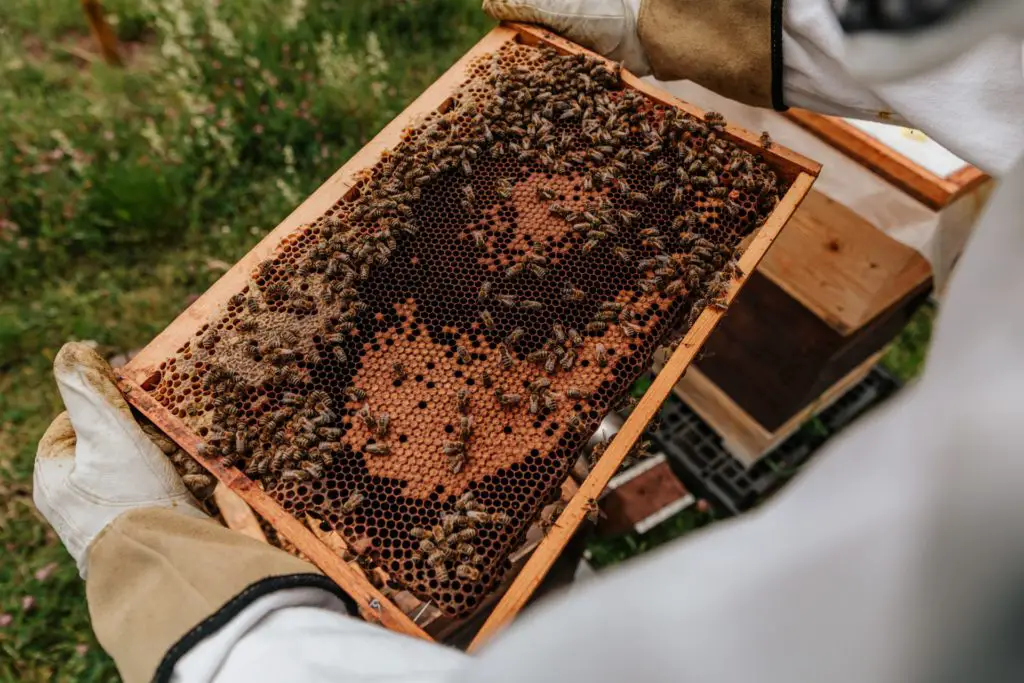
Do bee stings hurt?
Bee stings can hurt. Bee venom is designed to paralyze insects, so it can be quite painful when injected into human skin. The venom contains toxins that can cause an allergic reaction in some people. Symptoms of a bee sting allergy include:
- Hives
- Swelling
- Difficulty breathing
- Rapid pulse
- Dizziness
If you experience any of these symptoms after being stung by a bee, seek medical attention immediately.
Everyone needs to respect bees, especially beekeepers.
What to do if you’re stung by a bee
If you’re stung by a bee, you should remove the stinger as quickly as possible. You can do this by scraping it out with a fingernail, or using a credit card or other thin object. Apply ice to the area to reduce swelling, and take antihistamines if you’re experiencing an allergic reaction.
If you are experiencing mild symptoms, take an antihistamine and apply lavender oil to the area. This will help to soothe the skin and reduce swelling.
If you are experiencing a more severe reaction, seek medical attention immediately.
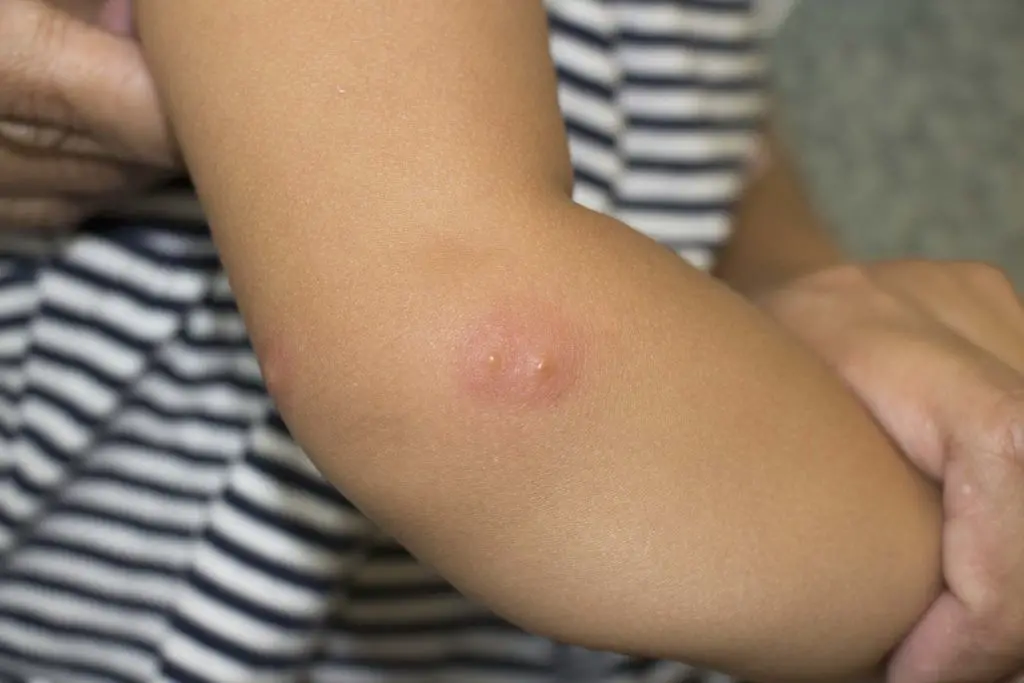
Can Bees Sting Through a Bee Suit
Bees can sting through a bee suit. Bee suits offer some protection against the full effect of an unprotected sting and can reduce the potential for bee stings.
Beekeepers who are comfortable handling bees should wear what they are most comfortable with, regardless of whether or not the suit is “sting proof”.
Bee suit removal can be dangerous for those who are not experienced in handling bees. Be careful when removing a bee suit to prevent further stinging.
How To Handle Bees Without Getting Stung
There’s no one definitive answer to this question – it will depend on the specific situation and the type of bee. However, some tips for how to handle bees without getting stung include avoiding sudden movements, wearing protective clothing, and using a beekeeper’s smoker to calm the bees.
Wear light-colored protective clothing and avoid blocking the hive entrance.
Slow movements will reduce aggression.
Fragrances can attract bees and increase direct contact, so it’s best to avoid using strong fragrances.
Listen to how the bees react and move slowly if necessary to not scare them off
How do beekeepers avoid getting stung?
Beekeepers avoid getting stung by wearing protective clothing and using smoke to calm the bees. Protective gear is necessary, especially headgear.
Beekeepers wanting to avoid getting any stings on their hands also wear beekeeping gloves.
And can you guess which body part is most vulnerable to bee stings while working in the hive? You guessed it right, it’s beekeeper’s hands!
Opening the hive might disrupt the bees and make them more prone to stinging, so beekeepers use a smoker to pacify the bees before opening the hive.
The smoker uses smoke to mask alarm pheromones that are released when a bee is disturbed.
These steps help Beekeepers from getting stung:
1. Wear protective gear
Beekeepers wear protective clothing to reduce the number of stings they receive.
Wearing a beekeeping suit or beekeeper jacket greatly reduces the number of stings you receive.
2. Use a smoker
Beekeepers use smoke to disarm bees and work the hive.
Smoke is also used when bees show signs of defensiveness, eg with abdomens raised and stings exposed.
If a hive can’t be worked without copious amounts of smoke, it should be requeened.
3. Work with the weather
Beekeepers leave their hives alone during cold, windy, and rainy weather
Beekeepers open their hives when there’s plenty of daylight left
Beekeepers never open their hives at night
4. Place your hive in a smart location
Beekeepers should place their hives in a smart location to avoid getting stung.
Bee stings can be dangerous for people who are allergic and should be taken seriously.
The first few stings may hurt the most.
5. Don’t walk in front of the hive
Beekeepers avoid standing in front of the hive entrance to avoid stings as this is where the bees are more active, coming in and out of the hive.
beekeepers place their hives in a safe location away from people and distractions.
beekeepers keep an eye on the hive and perform inspections when necessary.
6. Stay calm and never swat
Beekeepers avoid getting stung by following strategies such as never swatting at a bee, keeping calm, and staying still.
Beekeeping involves learning how to deal with bees to reduce the chance of getting stung.

How do you tame honey bees?
There is no one-size-fits-all answer to this question, as the best way to tame honey bees may vary depending on the particular situation. However, some tips on how to tame honey bees include providing them with a safe and comfortable home, feeding them sugar water, and keeping them calm.
Large numbers of bees swarming in a tree or around your home can be unnerving, but they are usually docile.
Bee swarms and nests can be safely managed if you follow careful procedures and get proper help.
Scout bees begin to canvass the surrounding territory for a potential new nesting site even before the swarm leaves its original colony.
Honey bees swarm and establish colonies to produce honey.
If the colony is killed and not immediately removed, honey will ferment and leak through walls and ceilings, causing damage.
When the bees locate the proper new nesting site, the swarm will fly off to the new location.
Honey bees are attracted to light and will fly to windows the next morning.
A well-established colony may have up to 100 pounds of honey, many pounds of adult and developing bees, and many wax combs.
Honey bees can be removed from a building using vacuum devices.
After extraction, all holes leading to spacious cavities in the building must be sealed.
Beekeepers might be willing to collect swarms for free, but generally, it isn’t worthwhile for them to remove established colonies without charge.
Honey bees are often seen in areas that have a high population of Africanized honey bees.
When honey bees are seen in an area, it is important to contact a professional to remove the swarm or colony.
Opening the hive and removing the bees can be done by a contractor and/or beekeeper cooperating with each other.
Working in isolation
Beekeepers who work in isolation should have effective means of communication so they can get help in an emergency.
Before leaving home, a beekeeper should advise family members or an appropriate person of the apiary location and expected time of returning home.
Effective means of communication, including receiving emergency radio bulletins during the proclaimed fire danger period, are important for monitoring any wildfires that might pose a safety risk.
Beekeepers should always carry a first aid kit and have a basic understanding of first aid when working with bees on hot days.
Beekeeping in hot weather
It is important to be aware of the dangers of working bees in hot weather. In hot weather, bees are more aggressive and are more likely to sting.
There are a few key pieces of equipment that must be considered even when beekeeping in hot weather: a smoker, veil, and suit. Some may be tempted to wear lighter clothing that provides less protection from bee stings.
Make sure to keep your smoker clean and well-maintained to avoid sickness among the bees. Keep your beekeeping equipment well-maintained to avoid problems during hot weather beekeeping season.
Conclusion
Beekeepers should always take necessary precautions to avoid getting stung when working with bees, especially during hot weather. Proper safety gear, such as a suit, veil, and smoker, should be worn at all times when working with bees. It is also important to stay calm and never swat at bees. By following these tips, beekeepers can safely handle honey bees.

